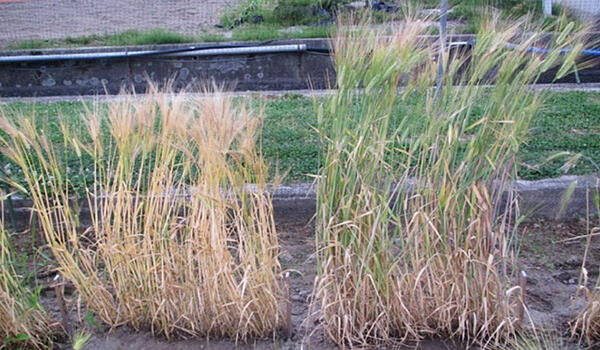Barley, the main ingredient of beer, was first brewed in Japan at the beginning of the Meiji era. It was originally a foreign crop but became established in Japan after approximately 150 years of breeding. Recent genetic analysis has revealed how the genes for resistance to deadly viral diseases were incorporated into the barley genome during the breeding process. There seemed to be another gene attached to the barley genome that was thought to have a negative effect on brewing. These findings will help in the development of a technology that can produce easier-to-grow and tastier beer barley in less time.

Provided by Professor Shin Taketa, Institute of Plant Science and Resources, Okayama University
Adapted for hot and humid climates
The main ingredients of beer are "malt," which is germinated barley, "hops," which gives bitterness, and "yeast," which performs alcoholic fermentation. When malt is boiled, the enzymes in the buds convert barley and other starches into sugars, producing sweet wort. Hops and yeast are then added in sequence to the sweet wort, resulting in alcoholic fermentation and maturation to form beer.
According to Professor Shin Taketa, who conducts research into Plant Breeding at the Institute of Plant Science and Resources at Okayama University, six-row barley, which is believed to have been introduced to Japan via China and the Korean peninsula during the Yayoi period (approximately 2,000 years ago), was cultivated in Japan. However, this barley was used as food, such as barley rice. Moreover, it has a high protein content, making it unsuitable for brewing beer.
Beer barley for brewing beer is believed to have been introduced in Japan approximately 150 years ago. "Japan Yokohama Brewery," the first beer brewery in Japan, was established in 1869 (Meiji 2); two-row barley, the beer barley, was imported from Europe, the U.S., and Australia in 1876. In 1891, the crossbreeding process began with the participation of both public and private sectors.
Barley can be grown in cooler climates; however, if it gets wet during harvest, its quality is severely compromised. For this reason, the "Golden Melon " and others that were originally imported were made as early maturing varieties that could be harvested before the rainy season. The "Amagi Nijo" and others were created over a period of approximately 100 years by breeding improvement to make them shorter and less prone to falling over. Thus, they are able to adapt to the hot and humid Japanese climate.

Provided by Professor Shin Taketa, Institute of Plant Science and Resources, Okayama University
Disease resistance achieved through breeding improvement since the 1970s
Breeding improvement efforts since the Meiji era have produced short, early maturing varieties; however, resistance of these varieties to soil-borne yellow mosaic caused by an RNA virus was required as this disease is soil transmitted. When yellow mosaic strikes, the leaves turn yellow, develop brown spots, and eventually die. If the disease is mild, the plant will recover as it grows; however, the growth will be poor, and the ears will be small and produce poor-quality fruit.

Provided by Professor Shin Taketa of the Institute of Plant Science and Resources, Okayama University
To produce virus-resistant beer barley, breeding improvement has been performed since the 1970s by crossbreeding food barley varieties, such as "Mokusekko 3" from China and "Haganemugi" from Japan. Currently, "Sukai Golden" and "Sachiho Golden" varieties that have acquired disease resistance are widely grown as high-quality beer barley.
The Institute of Plant Science and Resources, Okayama University, has been collecting and conserving barley genetic resources from all over the barley growing areas for more than half a century since the establishment of the barley lineage conservation facility in 1979. To determine how viral resistance was incorporated into Sukai Golden and Sachiho Golden, Taketa and his research group compared the genetic information of the two breeds with that of varieties whose genomes had already been analyzed and characteristic varieties.
RNA sequencing and SNP analysis
Taketa and his group sequenced RNA from immature seeds 20 days after flowering. Analysis of single nucleotide polymorphisms (SNPs), which indicate the variations in genetic information, revealed 2,419 SNPs in Sukai Golden and 3,058 SNPs in Sachiho Golden.
In Sukai Golden, SNPs were particularly clustered in two locations on chromosomes near viral resistance genes and pigment-related genes. In Sachiho Golden, there was no significant clustering of SNPs that appeared to be near the virus resistance gene. Unlike Sukai Golden, only the resistance gene was inherited from the native variety.
Based on the distribution of SNPs, "it seems that as the virus resistance gene is introduced through breeding, another gene from the edible parent is also attached without exception," says Taketa. It is assumed that the number of genes among the different genes that have a negative impact on brewing quality is not low.
If the gene can be identified and used as a standard marker for selection, it will be possible to determine whether only useful genes have been efficiently introduced. This will help in eliminating the need to grow the seeds to identify the trait, thus saving time and effort. We look forward to the day when these development efforts will result in barley that brews better beer.
(NAGASAKI Midoriko / Science Portal Editorial Office)
Original article was provided by the Science Portal and has been translated by Science Japan.




